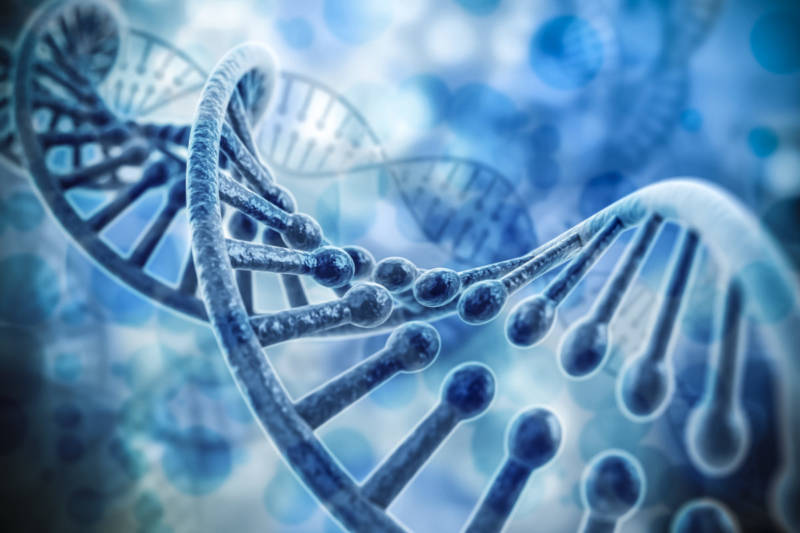For the millions of people infected with HIV, the best way to manage the disease is antiretroviral therapy, which can lower the amount of HIV replicating in the body to undetectable levels.
But antiretroviral therapy (ART) can only manage HIV, never eliminate it — leading people to rely on the expensive drugs for decades. Plus if ART is halted by these patients, HIV bounces back and its levels rise in a matter of weeks. In 2017 the World Health Organization reported that of 36.9 million people living with HIV, 21.7 million were taking ART.
A new study of mice charts a preliminary path to eliminating this medication dependency, through an injection of gene-editing CRISPR.
Removing HIV from a person’s body is so hard because “once the virus infects cells [the] viral genome integrates into the host genome and then becomes part of our DNA,” said Kamel Khalili, a neurovirologist at Temple University who co-led the study.
Once this integration happens, ART can’t reverse it — at least not on its own. But Khalili and his colleagues found combining CRISPR, which can alter DNA, with ART can remove the lingering signs of HIV in a mouse model of the disease. The collaborative effort between researchers at Temple University and the University of Nebraska Medical Center was reported today in Nature Communications.
Results in mouse models do not always translate into effective treatments in humans, but Fyodor Urnov says this study is an “important next step” in addressing a disease like HIV with a technique.
“Gene editing is the first-ever technology we have had to address disease at the DNA level,” said Urnov, who works at the Innovative Genomics Institute at the University of California Berkeley and was not involved in the study.
CRISPR, which scientists can program to cut DNA at specific sites, has garnered attention as a potential cure for genetic diseases, such as cystic fibrosis and muscular dystrophy. Using CRISPR and ART to develop an HIV cure could eventually eliminate the cost and distribution barriers that come with current treatments. To date, only two people have been cured of HIVafter receiving stem cell therapy to treat cancer. This expensive and invasive treatment has failed in every other HIV patient.
But CRISPR comes with its own caveats — namely, at the moment it isn’t as precise as many in the general public might think.
What the Study Did
The researchers used “humanized” mice, meaning mice were infused with the type of human immune cells that HIV infects.
In three separate trials, HIV-infected mice were given one of three injection therapies: a slow-release version of the common HIV drug ART, the CRISPR protein that finds and cuts genome-incorporated HIV, or a combination of the two.
After four weeks of ART treatment, the researchers dispensed CRISPR into the mice by packaging the protein inside of a completely separate virus, called adeno-associated virus, or AAV. AAV doesn’t cause illness, but it acts like a mail carrier, increasing the circulation of CRISPR. CRISPR then becomes more likely to find and cut out all of the HIV DNA, an essential step to prevent the disease from rebounding.
The researchers waited eight weeks after all the mice were taken off of ART, then searched for traces of HIV genetic material in blood, spleen, kidneys, gut, lungs, bone marrow and the brain.
After eight ART-free weeks, more than 30 percent of the mice that received ART and CRISPR lacked detectable amounts of HIV in any of the tissues the researchers studied.
In contrast, HIV was still detectable in all of the other mice, including those that were treated with ART or CRISPR alone.
A Cautious Way Forward
Though the researchers used “humanized mice,” the technology has a long way to go. “Clinical trials…will not start tonight. It will take a few years,” said Urnov. However, Khalili revealed that early data from preliminary trials in monkeys looks promising.
Khalili and his colleagues have applied to the U.S. Food and Drug Administration for permission to start human clinical trials as early as next year. Khalili has also launched a for-profit company that is developing CRISPR-based technology to treat disease.
That the technology is moving this fast concerns Zandrea Ambrose, a retrovirologist at the University of Pittsburgh, who was not involved in the study. CRISPR comes with a downside, in that it sometimes accidentally cuts the wrong gene.
Relative to other gene editors, CRISPR has fewer of these “off-target effects” as they’re called, but even a single error is worrisome. If CRISPR makes a hazardous mutation, it could disrupt any cell’s normal behavior and cause an inadvertent disease.
With billions of letters in the genome, it’s going to take a lot of work to avoid all possible off-target effects, Ambrose said. This study is promising, she added, but scientists in the CRISPR field need to get better at detecting these potential accidents.
Before clinical trials can begin, she said, researchers need to be sure these accidents won’t occur in humans by first testing them in animals. When researchers scanned the DNA from the “cured” mice, they didn’t find any signs that CRISPR had made cuts outside of the HIV DNA. But they could tell that CRISPR had made cuts within the HIV DNA, meaning the instructions for making new virus were broken.
Along with possible off-target effects, Ambrose worries that CRISPR, enclosed in an AAV virus, will remain in the body long after its job is done. If that’s the case, she says “there’s no way to turn” the CRISPR editing off, increasing the chances of an off-target cut.
But Khalili is confident that CRISPR is only cutting the DNA where it’s supposed to, based on searches for the “footprints” CRISPR leaves on DNA when it cuts. And CRISPR continues to improve everyday.
While a comprehensive, single-shot cure for HIV may be years away, Khalili is encouraged that this milestone “will give those affected hope.”
This story was originally published on PBS Newshour.

